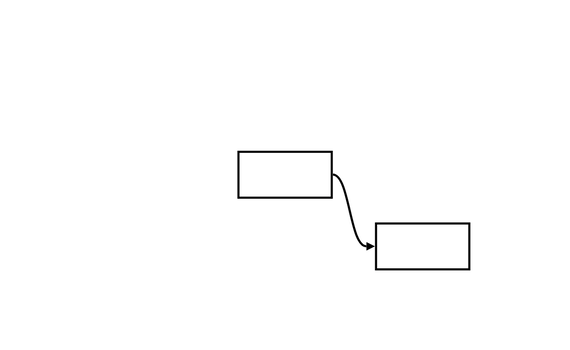A set of functions for drawing S-curved arrows between points and shapes.
getArrow- For point-to-point arrows (has glitches, not ready yet).getBoxToBoxArrow- For rectangle-to-rectangle arrows.
You may also want to see steveruizok's perfect-arrows, it's smarter but the start point and the end point are less predictable.
npm i curved-arrowsor
yarn add curved-arrowsThe functions in this library has similar arguments and return values to steveruizok's perfect-arrows. Notable differences are options and the return values containing two control points, one for start point and one end point, instead of one, to represent an S-curve.
The return values provide only the information needed to draw an arrow. You'll need to draw the arrow yourself using your technology of choice. See below for an example using React and SVG.
The getArrow function accepts the position of two points and returns an array containing this information:
- four points: start, end, and two control points (one for start, one for end)
- two angles: end and start
You can use this information to draw an S-curve and arrow heads. You can use the options object to tweak the return values.
const arrowHeadSize = 9
const arrow = getArrow(0, 0, 100, 200, {
padStart: 0,
padEnd: arrowHeadSize,
})
const [sx, sy, c1x, c1y, c2x, c2y, ex, ey, ae, as] = arrow| Argument | Type | Description |
|---|---|---|
x0 |
number | The x position of the starting point. |
y0 |
number | The y position of the starting point. |
x1 |
number | The x position of the ending point. |
y1 |
number | The y position of the ending point. |
options |
object | An (optional) object containing one or more of the options described below. |
| Option | Type | Default | Description |
|---|---|---|---|
padStart |
number | 0 | How far the arrow's starting point should be from the provided start point. |
padEnd |
number | 0 | How far the arrow's ending point should be from the provided end point. |
| Argument | Type | Description |
|---|---|---|
sx |
number | The x position of the (padded) starting point. |
sy |
number | The y position of the (padded) starting point. |
c1x |
number | The x position of the control point of the starting point. |
c1y |
number | The y position of the control point of the starting point. |
c2x |
number | The x position of the control point of the ending point. |
c2y |
number | The y position of the control point of the ending point. |
ex |
number | The x position of the (padded) ending point. |
ey |
number | The y position of the (padded) ending point. |
ae |
number | The angle (in degree) for an ending arrowhead. |
as |
number | The angle (in degree) for a starting arrowhead. |
The getBoxToBoxArrow function accepts the position and dimensions of two boxes (or rectangles) and returns an array containing this information:
- four points: start, end, and two control points (one for start, one for end)
- two angles: end and start
You can use this information to draw an S-curve and arrow heads. You can use the options object to tweak the return values.
Note: The options and values returned by getBoxToBoxArrow are in the same format as the options and values for getArrow.
const arrowHeadSize = 9
const arrow = getArrow(0, 0, 200, 100, 300, 50, 200, 100, {
padStart: 0,
padEnd: arrowHeadSize,
})
const [sx, sy, c1x, c1y, c2x, c2y, ex, ey, ae, as] = arrow| Argument | Type | Description |
|---|---|---|
x0 |
number | The x position of the first rectangle. |
y0 |
number | The y position of the first rectangle. |
w0 |
number | The width of the first rectangle. |
h0 |
number | The height of the first rectangle. |
x1 |
number | The x position of the second rectangle. |
y1 |
number | The y position of the second rectangle. |
w1 |
number | The width of the second rectangle. |
h1 |
number | The height of the second rectangle. |
options |
object | An (optional) object containing one or more of the options described below. |
See options in getArrow above. (Both functions use the same options object.)
See returns in getArrow above. (Both functions return the same set of values.)
import * as React from 'react'
import { getArrow } from 'curved-arrows'
export function Arrow() {
const p1 = { x: 100, y: 100 }
const p2 = { x: 300, y: 200 }
const arrowHeadSize = 9
const color = 'black'
const [sx, sy, c1x, c1y, c2x, c2y, ex, ey, ae] = getArrow(p1.x, p1.y, p2.x, p2.y, {
padEnd: arrowHeadSize,
})
return (
<svg
width="100%"
height="100%"
xmlns="http://www.w3.org/2000/svg">
<path
d={`M ${sx} ${sy} C ${c1x} ${c1y}, ${c2x} ${c2y}, ${ex} ${ey}`}
stroke={color}
strokeWidth={arrowHeadSize / 2}
fill="none"
/>
<polygon
points={`0,${-arrowHeadSize} ${arrowHeadSize *
2},0, 0,${arrowHeadSize}`}
transform={`translate(${ex}, ${ey}) rotate(${ae})`}
fill={color}
/>
</svg>
)
}

